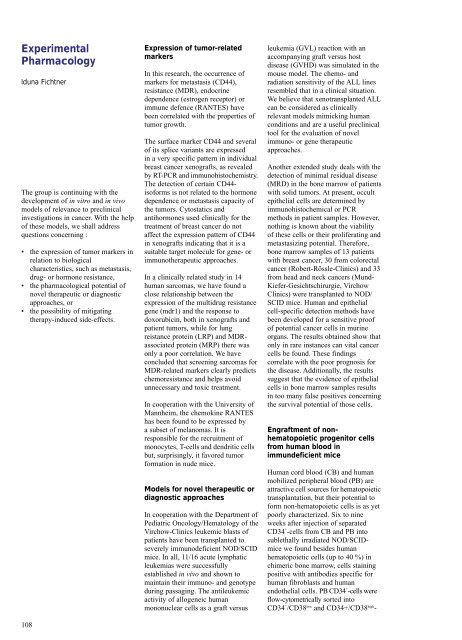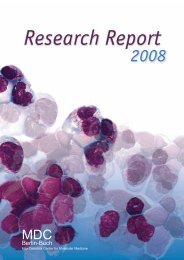You also want an ePaper? Increase the reach of your titles
YUMPU automatically turns print PDFs into web optimized ePapers that Google loves.
Experimental<br />
Pharmacology<br />
Iduna Fichtner<br />
The group is continuing with the<br />
development of in vitro and in vivo<br />
models of relevance to preclinical<br />
investigations in cancer. With the help<br />
of these models, we shall address<br />
questions concerning :<br />
• the expression of tumor markers in<br />
relation to biological<br />
characteristics, such as metastasis,<br />
drug- or hormone resistance,<br />
• the pharmacological potential of<br />
novel therapeutic or diagnostic<br />
approaches, or<br />
• the possibility of mitigating<br />
therapy-induced side-effects.<br />
108<br />
Expression of tumor-related<br />
markers<br />
In this research, the occurrence of<br />
markers for metastasis (CD44),<br />
resistance (MDR), endocrine<br />
dependence (estrogen receptor) or<br />
immune defence (RANTES) have<br />
been correlated with the properties of<br />
tumor growth.<br />
The surface marker CD44 and several<br />
of its splice variants are expressed<br />
in a very specific pattern in individual<br />
breast cancer xenografts, as revealed<br />
by RT-PCR and immunohistochemistry.<br />
The detection of certain CD44isoforms<br />
is not related to the hormone<br />
dependence or metastasis capacity of<br />
the tumors. Cytostatics and<br />
antihormones used clinically for the<br />
treatment of breast cancer do not<br />
affect the expression pattern of CD44<br />
in xenografts indicating that it is a<br />
suitable target molecule for gene- or<br />
immunotherapeutic approaches.<br />
In a clinically related study in 14<br />
human sarcomas, we have found a<br />
close relationship between the<br />
expression of the multidrug resistance<br />
gene (mdr1) and the response to<br />
doxorubicin, both in xenografts and<br />
patient tumors, while for lung<br />
reistance protein (LRP) and MDRassociated<br />
protein (MRP) there was<br />
only a poor correlation. We have<br />
concluded that screening sarcomas for<br />
MDR-related markers clearly predicts<br />
chemoresistance and helps avoid<br />
unnecessary and toxic treatment.<br />
In cooperation with the University of<br />
Mannheim, the chemokine RANTES<br />
has been found to be expressed by<br />
a subset of melanomas. It is<br />
responsible for the recruitment of<br />
monocytes, T-cells and dendritic cells<br />
but, surprisingly, it favored tumor<br />
formation in nude mice.<br />
Models for novel therapeutic or<br />
diagnostic approaches<br />
In cooperation with the Department of<br />
Pediatric Oncology/Hematology of the<br />
Virchow-Clinics leukemic blasts of<br />
patients have been transplanted to<br />
severely immunodeficient NOD/SCID<br />
mice. In all, 11/16 acute lymphatic<br />
leukemias were successfully<br />
established in vivo and shown to<br />
maintain their immuno- and genotype<br />
during passaging. The antileukemic<br />
activity of allogeneic human<br />
mononuclear cells as a graft versus<br />
leukemia (GVL) reaction with an<br />
accompanying graft versus host<br />
disease (GVHD) was simulated in the<br />
mouse model. The chemo- and<br />
radiation sensitivity of the ALL lines<br />
resembled that in a clinical situation.<br />
We believe that xenotransplanted ALL<br />
can be considered as clinically<br />
relevant models mimicking human<br />
conditions and are a useful preclinical<br />
tool for the evaluation of novel<br />
immuno- or gene therapeutic<br />
approaches.<br />
Another extended study deals with the<br />
detection of minimal residual disease<br />
(MRD) in the bone marrow of patients<br />
with solid tumors. At present, occult<br />
epithelial cells are determined by<br />
immunohistochemical or PCR<br />
methods in patient samples. However,<br />
nothing is known about the viability<br />
of these cells or their proliferating and<br />
metastasizing potential. Therefore,<br />
bone marrow samples of 13 patients<br />
with breast cancer, 30 from colorectal<br />
cancer (Robert-Rössle-Clinics) and 33<br />
from head and neck cancers (Mund-<br />
Kiefer-Gesichtschirurgie, Virchow<br />
Clinics) were transplanted to NOD/<br />
SCID mice. Human and epithelial<br />
cell-specific detection methods have<br />
been developed for a sensitive proof<br />
of potential cancer cells in murine<br />
organs. The results obtained show that<br />
only in rare instances can vital cancer<br />
cells be found. These findings<br />
correlate with the poor prognosis for<br />
the disease. Additionally, the results<br />
suggest that the evidence of epithelial<br />
cells in bone marrow samples results<br />
in too many false positives concerning<br />
the survival potential of those cells.<br />
Engraftment of nonhematopoietic<br />
progenitor cells<br />
from human blood in<br />
immundeficient mice<br />
Human cord blood (CB) and human<br />
mobilized peripheral blood (PB) are<br />
attractive cell sources for hematopoietic<br />
transplantation, but their potential to<br />
form non-hematopoietic cells is as yet<br />
poorly characterized. Six to nine<br />
weeks after injection of separated<br />
CD34 + -cells from CB and PB into<br />
sublethally irradiated NOD/SCIDmice<br />
we found besides human<br />
hematopoietic cells (up to 40 %) in<br />
chimeric bone marrow, cells staining<br />
positive with antibodies specific for<br />
human fibroblasts and human<br />
endothelial cells. PB CD34 + -cells were<br />
flow-cytometrically sorted into<br />
CD34 + /CD38 low and CD34+/CD38 high -

















